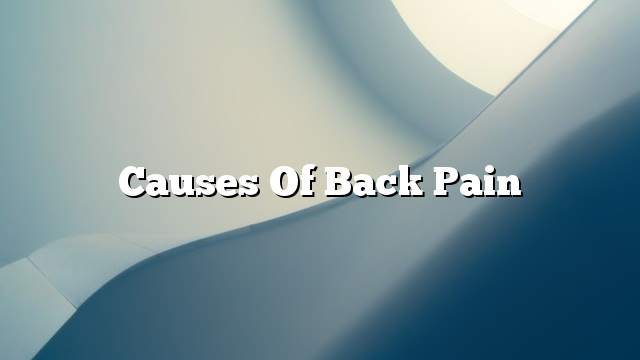Back pain
Back pain is a common condition for all people in all age groups, for various reasons ranging from neurological or joint problems. The severity of the pain varies with the main cause. In order to treat this type of pain, the main reason for proper treatment and prevention In the future, and to help with this we devoted this article to mention the most common causes of back pain.
Causes of Back Pain
Muscle Stress
Tired activities, such as: carrying heavy weights or doing erratic and sudden movements that strain the muscles and ligaments that connect the vertebral vertebrae, especially if your health condition is not as it should be in its vitality and activity, in which case any strong activity can strain the muscles The back thus causes pain.
Swelling and torn back cushions and cartilage
Pillars and cartilage are the layers between each vertebra that act as a pad to reduce friction between the vertebrae and therefore prevent corrosion. If this lining is displaced or torn, pressure is created on the nerves causing pain.
arthritis
Arthritis affects the vertebrae of the spine as well as the extremities of the body. In this case, the area around the spinal cord is narrowed causing back pain in a health condition called spinal stenosis.
Make the wrong movements
Some erroneous movements and sudden movement of the spine may lead to transitions to one side in rare cases leading to back pain.
Osteoporosis
Osteoporosis can lead to poor back pain, pressure, and neck pain.
other reasons
- One may experience back pain sometimes as a symptom of cancerous tumors.
- Situations of unhealthy sitting for long periods.
- Diseases such as kidney disease and uterine diseases cause back pain.
- Pregnant women may suffer back pain due to the weight of the weight of the uterus and pressure on the back.
Symptoms of Back Pain
- Pain in the back muscles extends from the neck and through the length of the spine until the end of the back.
- Inability to stand properly and straight, especially for long periods because of the feeling of severe pain.
- Feeling like someone takes painful stabs in the back.
- Feeling pain down the legs.
- Loss of flexibility and inability to exercise any activity requires flexibility, especially the user’s back muscles.
- Feeling mid or lower back pain when sitting or standing for long periods of time.
- Feeling of pain from the lower back and stretching to the buttocks, thighs and sometimes down to the feet.
- Pain occurs in one of the areas of the back, and may be distributed all over, and this symptom is one of the most common symptoms.
- Difficulty walking, moving.
- Feeling uncomfortable while sitting, or standing.
- Hear sounds emanating from the vertebrae, bones.
Treatment
During the diagnosis of back pain, the orthopedic specialist depends on the causes of the pain, the symptoms on the patient, through clinical examination, and the operation of a chest x-ray to determine the nature of the injury.
The doctor may use laboratory tests to determine if the cause of the pain is a bacterial infection. A magnetic resonance session can be performed to photograph the details of the bones in the back. Pain medication and antibiotics are prescribed if the infection is based on inflammation. It is possible that the patient needs a bone massage, and in advanced cases, surgery is performed.
Protection from it
There are a range of procedures that help protect against back pain, including:
- Keep eating healthy, to avoid weight gain that affects the spine.
- Exercise to reduce the risk of joint and bone diseases.
- Carry the objects with the appropriate weights, avoid carrying anything heavy, so as not to cause pain in the back.
- Take a break after finishing work.
- Hiking is suitable for muscle movement.
- Choose the size, the chair length is suitable to sit on it, especially when sitting for long periods of time.
- Lie down on a comfortable mattress.
